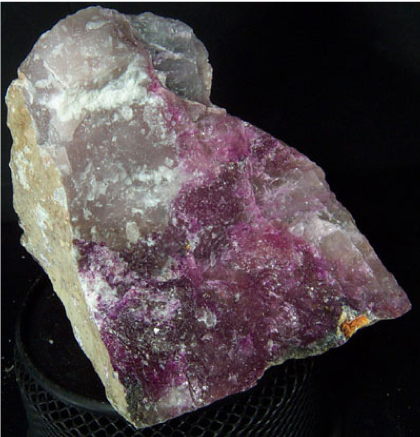Tunuliarfik Minerals - The Fluorescent Minerals of Greenland – Part 4
We will divide this blog into a 4 series post with a focus on the following areas:
- Overview of Greenland and the Fluorescent Minerals from this Locality
- Taseq Slope Minerals
- Kvanefjeld Minerals
- Tunuliarfik Minerals
- Kangerlussaq Minerals

Photo courtesy of Herb Yeates
Tunulliarfik
The Tunulliarfik Fjord cuts right through the middle of the Ilimaussaq Complex. Traveling by boat from Narsaq the sights are wondrous; the deep blue water of the fjords broken by massive white and blue icebergs contrasts remarkably to the rocky cliffs and sparse vegetation on either side of the fjord. Upon approaching the transition zone into the complex the appearance of the land changes abruptly. There is almost a complete absence of vegetation due to the rapid weathering of the friable syenites – only gray rocks with an occasional white vein high above.

Boulders lie at the water’s edge and landslide areas offer up exciting areas to prospect. Gem quality ussingite, massive veins of sodalite, and brilliant assortments of multi-color tugtupite specimens can all be found here.
Tunuliarfik Minerals

Ussingite, Sodalite, Chkalovite, Tugtupite and Polylithionite – Ussingite seems closely related to sodalite and may even be mistaken for it. The ussingite from the Tunuliarfik area is possibly the best in the complex. Gem quality pieces are found, usually associated with sodalite, tugtupite and polylithionite - making for a striking 4 or 5 color specimen. One of the mysteries of ussingite is its fluorescence – the response seems to vary from bright orange to bright green to none (or very dim).


“Tugtulite” – Tugtup Agtakôrfia is a small area right on the water in the Tunuliarfik Fjord. It is the type locality for tugtupite – discovered in 1962 by Sorensen. All of the pink/red tugtupite has since been mined and all that was left in the vein were some remarkable specimens of sodalite and what was previously an unknown mineral (we now know it is tugtupite). This tugtupite has three distinct color states under each wavelength - bright peach under shortwave UV light, bright white under midwave UV light, and bright orange under longwave UV light. Additionally it is extremely phosphorescent a greenish white - lasting for a very long time.
"Tugtulite" is a generic term we use to describe tugtupite which has these three distinct color states under midwave, shortwave, longwave and its strong phosphorescence. We use it for any piece which exhibits this unique fluorescent response. Tugtulite by any other color is still tugtupite.
We made many significant discoveries over the 11 years we conducted tours to Greenland, and this was one of the major ones. Since the original find of “Tugtulite” was first at Tugtup Agtakôrfia, we made a second discovery of a second deposit on the Taseq Slope, only a few hundred meters away. This deposit has the same UV responsive tugtupite, but is associated with more polylithionite (referred to as "silver poly").
The nickname “Tugtulite” was originally coined for a specific mix of tugtupite and sodalite initially discovered at the type locale for tugtupite, Tugtup Agtakôrfia. The original backstory of Tugtulite is as follows: Way back in 2002, when we were first conducting tours to Greenland, one of the members on the very first tour found this beautiful rock at Tugtup Agtakôrfia. He wasn’t even using a light! His son wanted to go fishing with one of our boat operators but he had little interest in anything but rocks and asked to be dropped at a little promontory to hunt for rocks (sans light). Picked up a pretty rock and brought it back with him, only to discover what a beauty it was.
Later, after investigation we learned that he was actually collecting at the same spot where Sorenson discovered tugtupite in the 50’s. Next tour we went back and found more but had no idea what it was. It was fluorescent a peach color under shortwave UV, white under midwave, and salmon under longwave (that was a hint). And it came from the type locality for tugtupite (the exact place where tugtupite was originally discovered in 1958). Back in the states, we sent some pieces out for analysis. EDS came back and called it a “homogenous blend of tugtupite and sodalite”. Thus we nicknamed it “tugtulite” and sold it as such (and of course told people what the actual EDS results were). The criticism we received was overwhelming - “How could we invent a nickname for a mineral!”
The nickname stuck. We have since learned that this material is a unique variety of tugtupite, and the proper identification is truly tugtupite.
Fluorescent Sodalite
Major specimens of fluorescent sodalite can be found in these areas. One new area produces fantastic specimens of hackmanite - a color change variety of sodalite. This material is so sensitive to UV that it changes color even in the sunlight, and almost turns black under SW.


Solid Sodalite – Some of the nicest solid pieces of sodalite have been found in the Tunulliarfik areas. These pieces are simply glowing embers under UV light. They are often quite tenebrescent, and can overwhelm almost any piece placed next to it in a display cabinet. Natural colors range from a pale white to a deep green and most are quite translucent.


Pea-Green Sodalite – An exceptionally bright variety of sodalite comes from a single area within the Tunulliarfik Fjord. This variety is colored a bright “pea-green” under natural light. It is somewhat coarse grained with aegirine distributed throughout. Under longwave the pieces glow as if they were on fire. Interestingly, they are not usually tenebrescent, but tenebrescent pieces have been found.


Blue Sodalite - Several trips were made to a new area where very fluorescent blue sodalite is found. We discovered a new vein of material which the tour members proceeded to pillage any way they could. The natural color is a beautiful blue - one of the only blue sodalites which is strongly fluorescent. This material is very tenebrescent, but also a quite beautiful fluorescent mineral.
Many of the pieces from this locality within the complex are associated with a relatively bright fluorescent feldspar (in syenite). Like other feldspars, it fluoresces a magenta color.

